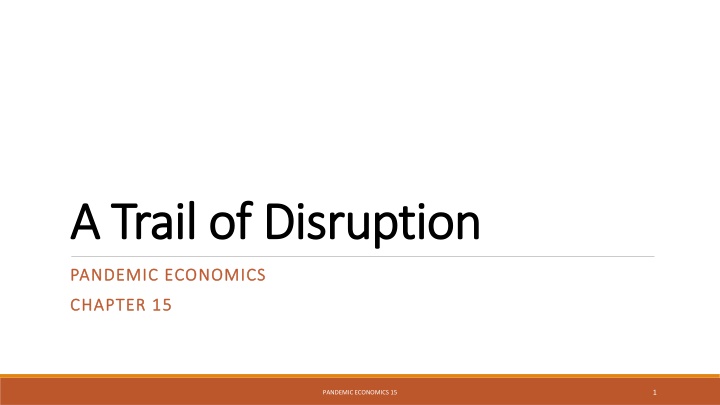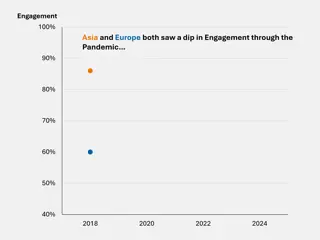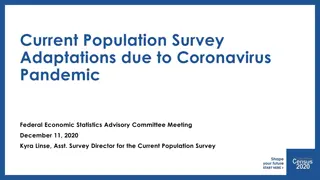Economic Effects of the Coronavirus Pandemic
The coronavirus pandemic led to economic loss, social discord, and uncertainty, impacting various sectors such as health, inequality, environment, education, technology, and international cooperation. This chapter explores the lasting effects on the economy, changes in unemployment, digital interaction, and the importance of policy implementation in addressing the global shock caused by the pandemic.
Download Presentation

Please find below an Image/Link to download the presentation.
The content on the website is provided AS IS for your information and personal use only. It may not be sold, licensed, or shared on other websites without obtaining consent from the author.If you encounter any issues during the download, it is possible that the publisher has removed the file from their server.
You are allowed to download the files provided on this website for personal or commercial use, subject to the condition that they are used lawfully. All files are the property of their respective owners.
The content on the website is provided AS IS for your information and personal use only. It may not be sold, licensed, or shared on other websites without obtaining consent from the author.
E N D
Presentation Transcript
A Trail of Disruption A Trail of Disruption PANDEMIC ECONOMICS PANDEMIC ECONOMICS CHAPTER 15 CHAPTER 15 1 PANDEMIC ECONOMICS 15
1. Economic Loss, Social Discord, and Uncertainty 2. A Set of Pandemic Outcomes 3. Economic Effects Topics Topics 4. Health Effects and Inequality of Outcomes 5. Effects on the Environment, Education, and Technology 6. International, Spatial, and Cooperative Effects 7. Policy and Social Effects 2 PANDEMIC ECONOMICS 15
Learning Objectives Learning Objectives After reading this chapter, you will be able to: After reading this chapter, you will be able to: LO1 Explain why the coronavirus pandemic served as a global shock. LO2 Identify the effects on the economy, health, inequality, environment, education, technology, economic geography, cooperation, policy, and society. LO3 Analyze changes in the economy, including unemployment effects, digital interaction, and remote work. LO4 Discuss the lasting effects on health and inequality, including emergency care and poverty. LO5 Argue that a pandemic impacts the environment, education, and the process of technological advance. LO6 Address why a pandemic alters international, spatial, and cooperative outcomes. LO7 Discuss the importance of policy implementation and social outcomes. 3 PANDEMIC ECONOMICS 10
The novel coronavirus that spread throughout the world during the year 2020 led to an economic collapse and a health crisis. 1. Economic 1. Economic Loss, Social Loss, Social Discord, and Discord, and Uncertainty Uncertainty The twin economic and health crises intensified economic and social changes that were already underway. Overall, an uncertain environment affected attitudes toward consumption, savings, and investment, the decisions, big and small, that impacted the course of the economy. 4 PANDEMIC ECONOMICS 15
Economic Recovery Economic Recovery Whether countries settled into a period of slower economic growth or used the momentum of government intervention, investment in skills and security, and technological advance to accelerate economic prosperity depended on collective action, economic ingenuity, and the willingness to adapt to changing economic circumstances. 5 PANDEMIC ECONOMICS 15
Robert J. Shiller (Yale University) Robert J. Shiller (Yale University) Big events like a pandemic have the potential to leave behind a trail of disruption. They can create social discord, reduce people s willingness to spend and take risks, destroy business momentum and shake confidence in the value of investments. 6 PANDEMIC ECONOMICS 15
A pandemic leads to both short-term changes and the potential for long-term outcomes. 2. A Set of 2. A Set of Pandemic Pandemic Outcomes Outcomes In many countries the coronavirus pandemic crippled markets, created recessions, and decreased economic activity in multiple sectors, including travel, retail, and aviation. 7 PANDEMIC ECONOMICS 15
Economy: shutdown, recession, recovery Health: mortality, morbidity, life expectancy Society: isolation, loneliness, anxiety Policy: quarantines, social distancing, sheltering-in-place Inequality: pre- existing conditions, access to healthcare Pandemic outcomes Mutual Environment: energy, pollution, greenhouse gases interdependence: cooperation, defection, coercion Spatial economics: rural areas, urban areas, economic concentration Education: remote learning, online courses, digital divide International: globalization, supply chains, developing economies Technology: invention, innovation, diffusion, adoption 8 PANDEMIC ECONOMICS 15
Large economic downturns disrupt employment and consumer spending. Because a pandemic-induced economic crisis leads to a service-sector recession, it disproportionately impacts both young people and women. 3. Economic 3. Economic Effects Effects As the economic toll increases, many of these individuals experience shorter work schedules, unemployment, or an exit from the labor market. 9 PANDEMIC ECONOMICS 15
Unemployment Unemployment For many individual workers, the pandemic recession reduces both job prospects and lifetime earnings. Despite policies that provide financial support, many of the unemployed do not receive a sufficient level of aid during shutdown and recession. 10 PANDEMIC ECONOMICS 15
Labor Market Labor Market During economic recovery, economies recovered most of the jobs that were lost during the downturn. But many positions did not return, even after the dissemination of a vaccine. The reason was that some economic sectors did not return to their pre- pandemic levels of employment. 11 PANDEMIC ECONOMICS 15
Digital Interaction Digital Interaction The economic shutdown triggered by the pandemic led to an increase in demand for digital interaction. New technology for group projects, conferences, and meetings replaced previous methods. In many industries, individuals adopted digital tools for the exchange of ideas. 12 PANDEMIC ECONOMICS 15
Remote Work Remote Work The growth of digital interaction allowed businesses to increase their level of remote work. For flexible jobs, this change meant fewer commutes, less time in the office, and more control over the work environment. In the presence of these benefits, companies may extend policies for remote work, offering a flexible model with clear expectations about deadlines and performance. 13 PANDEMIC ECONOMICS 15
E E- -Commerce Commerce The market conditions contributing to the growth in e-commerce were apparent long before the coronavirus pandemic. But the increase in e-commerce signaled the evolution of the retail industry, the infusion of technology, and the permanent shift in how consumers shop. 14 PANDEMIC ECONOMICS 15
Many countries are vulnerable to a large health shock because they lack the ability to provide healthcare resources for everyone. 4. Health 4. Health Effects and Effects and Inequality of Inequality of Outcomes Outcomes Countries with unequal access to healthcare resources may struggle in the absence of an effective mechanism of redistribution, as both income and wealth inequality make entire segments of the population more vulnerable during a crisis. 15 PANDEMIC ECONOMICS 15
LONG-TERM HEALTH EFFECTS EMERGENCY CARE AND TELEMEDICINE Because human immune systems had not previously experienced the SARS- COV-2 strain, they were unable to stop the negative health outcomes. During the pandemic, many hospitals established guidelines for when patients should use telemedicine and when they should seek immediate care. 16 PANDEMIC ECONOMICS 15
Inequality of Outcomes Inequality of Outcomes During a pandemic, conventional wisdom is that the disease serves as a great equalizer. At first glance, the disease crosses borders and does not discriminate according to income or socioeconomic status. However, because of a higher prevalence of pre-existing medical conditions and less access to healthcare, a pandemic disproportionately impacts members of marginalized communities. 17 PANDEMIC ECONOMICS 15
PANDEMICS AND INEQUALITY POVERTY A pandemic reveals pre-existing levels of inequality in a society, whether measured through income, wealth, or access to resources. During a pandemic, the poorest members of society experience a disproportionate burden. The poor have less access to healthcare systems. 18 PANDEMIC ECONOMICS 15
5. Effects on 5. Effects on Environmental, educational, and technological outcomes led to lower pollution levels and innovation in online education. the the Environment, Environment, Education, and Education, and Technology Technology These disruptions altered business and social outcomes. 19 PANDEMIC ECONOMICS 15
Environmental Outcomes Environmental Outcomes The industrial slowdown grounded planes, reduced factory operation, and decreased transportation, distribution, and the consumption of fossil fuels. These outcomes decreased both air pollution and greenhouse gas emissions. 20 PANDEMIC ECONOMICS 15
DEFORESTATION VALUING THE ENVIRONMENT During the pandemic, land grabbers, illegal loggers, and miners took advantage of the distraction to clear large tracts of the Amazonian rainforest with impunity. The decline in economic activity, so disruptive with respect to employment and production, led to quieter streets where traffic normally flows, cleaner skies where pollution usually exists, and animal sightings. 21 PANDEMIC ECONOMICS 15
CLIMATE CHANGE Even though fewer greenhouse gas emissions are a positive outcome from a climate perspective, it is likely a short-run blip. 22 PANDEMIC ECONOMICS 15
Educational Outcomes Educational Outcomes The coronavirus pandemic altered the process of education. Schools opened and closed in an intermittent pattern, depending on the status of the disease. The pressure on teachers and students led to unfamiliar educational outcomes. The digital divide aggravated inequalities. 23 PANDEMIC ECONOMICS 15
REMOTE LEARNING BUDGET CUTS Delivering educational content in a remote learning environment increases the demand for guidance, internet access, and technological literacy. During the coronavirus pandemic, tax revenue flowing to government decreased. As a result, public sector funding of institutions of higher education declined. 24 PANDEMIC ECONOMICS 15
DIGITAL DIVIDE WORK EFFORT While teleconferencing and network technologies encouraged remote learning, many students were left behind. The reason was the digital divide, a lack of internet access and/or electronic devices among lower- income students. In the developing world, the closure of schools forced many children to find work. Because parents may have lost their jobs, families needed money. 25 PANDEMIC ECONOMICS 15
Technological Advance Technological Advance TECHNOLOGY COMPANIES NEW TECHNOLOGY During the coronavirus pandemic, many technology companies flourished with the growth of cloud computing, social networking, videoconferencing, online education and entertainment, and delivery-on- demand. During the coronavirus pandemic, new technology was developed in many areas, including disease detection and containment, the provision of healthcare, management of information, and cybersecurity. 26 PANDEMIC ECONOMICS 15
6. 6. The coronavirus pandemic: Disrupted international trade and global supply chains, increasing the cost of shipping goods and challenging the process of economic recovery. Impacted urban and rural areas in different ways. Led to alternative outcomes with respect to cooperative effects. International, International, Spatial, and Spatial, and Cooperative Cooperative Effects Effects 27 PANDEMIC ECONOMICS 15
International Effects International Effects Economies with extensive global supply chains become more aware of the risk of single points of failure. One response, protectionism, encourages countries to look inward but includes its own costs, including severed supply chains. Another response, globalization, encourages countries to grapple with the challenges of helping workers and growing economies in a world with the potential for major economic disruptions. 28 PANDEMIC ECONOMICS 15
Reconceptualizing the Urban Reconceptualizing the Urban Urbanism involves a city s way of life, including its design and level of economic development. In economics, the idea of a dense city as an incubator for economic and social progress serves as a central theme. The diversity and population density of urban areas creates centers of innovation. 29 PANDEMIC ECONOMICS 15
THE VALUE OF URBAN LIFE INFLECTION POINT Cities experience disease, the shutdown of restaurants, shops, and museums, and shift to remote work. For urban areas, a pandemic creates an inflection point: the shock exposes systematic problems, raises the question of the feasibility of returning to pre-pandemic patterns of exchange, and reveals ways to improve urban life. 30 PANDEMIC ECONOMICS 15
Cooperation Cooperation Populations under collective threat experience pressure to tighten their social norms and punish those who deviate from a cooperative position. During periods of major disruption, rules and punishments that discourage free riders are necessary for groups to coordinate their behavior. But cultural characteristics determine how a population responds. 31 PANDEMIC ECONOMICS 15
Public policy to fight the pandemic differs between countries due to the public sector s allocation of resources, competence, and foresight. The ability to implement comprehensive systems of testing, tracing, and supported isolation requires enforcement, a realistic timeframe, and cooperation. At the same time, a pandemic creates the opportunity to correct market failures, improve public institutions, and address inequalities. It also threatens to overwhelm economic and social systems. The extent to which a country balances these potential outcomes determines the trajectory of both health and economic effects. 7. Policy and 7. Policy and Social Effects Social Effects 32 PANDEMIC ECONOMICS 15
Policy Effects Policy Effects The coronavirus pandemic forced countries to implement policy in the absence of full information on the spread of disease. In many countries, the failure of initial containment efforts led to the implementation of non-pharmaceutical interventions. These policies decreased economic activity, restricted travel, and closed schools. 33 PANDEMIC ECONOMICS 15
Social Effects Social Effects BIRTH RATES ISOLATION During a time of recession, uncertainty, and insecurity, many individuals are reluctant to seek commitments. If they lack economic security, they may postpone long-term relationships. As these factors take hold, the birth rate declines. During a pandemic, societies experience the social cost of isolation, because connections are crucial for human well-being. Problems emerge, including domestic violence, mental health issues, and substance abuse. 34 PANDEMIC ECONOMICS 15























